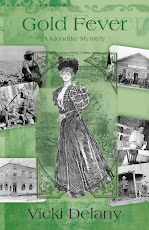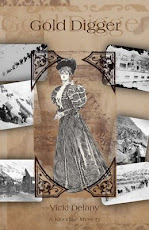I'll be running something about the Klondike every Friday until the end of December, so please check back often.
----------------------
The
Klondike in 1896, when the rush began, was most definitely not the “wild
west”. Please don’t think Deadwood.
Because
in this case, the police were there first.
The
border between the US and Canada was still in dispute. Some gold had
been discovered at Forty Mile, just inside the Canadian border, and a small
settlement set up there. The Canadian government wanted to enforce its claim,
so sent a group of North West Mounted Police (NWMP) to the territory in 1894, under the control of Inspector Charles
Constantine. On arrival they set up a fort and established the police presence.
 Thus the NWMP was firmly in place when tens of
thousands of people began pouring into the territory in 1897-98. And
what all those miners and dance hall owners, prostitutes and pimps, bartenders
and adventurers, and businessmen (respectable and shady) found when they at
long last arrived in the promised land, was the long arm of the law waiting for
them, in the form of the North West Mounted Police (precursors of the RCMP).
Thus the NWMP was firmly in place when tens of
thousands of people began pouring into the territory in 1897-98. And
what all those miners and dance hall owners, prostitutes and pimps, bartenders
and adventurers, and businessmen (respectable and shady) found when they at
long last arrived in the promised land, was the long arm of the law waiting for
them, in the form of the North West Mounted Police (precursors of the RCMP).
Prostitution
and gambling were illegal in all parts of Canada, but the NWMP recognized,
wisely in my opinion, that some things were going to happen whether they were
legal or not, and the police would be better having some control.
So
prostitution was practiced openly and dance halls all had a gambling room.
Police oversight was strict and they could, and did, close down any business
stepping over the line. However, there were things the Mounties didn’t bend on
– the use of ‘vile language’ was an offence, and Sunday closing was strictly
observed. People were jailed for chopping wood for their own homes on a Sunday.
Firearms were strictly banned. Every person coming into the Territory was
required to have a year’s supply of goods with them: a lesson learned during
the winter of 1897-98 when the town nearly starved.
In
1898, the year of the height of the Gold Rush, when the town of Dawson had a
population of 40,000, there was not one murder in town. Not one. Reports I have
read say that people were comfortable leaving their doors unlocked and their
possessions out in the open. In contrast to the nearby town of Skagway,
Alaska, where gangsters such as Soapy Smith ruled and crime and corruption were
rampant. Soapy himself was killed in a shootout on the Skagway boardwalk in
July 1898.
Not one murder. Well, I’ve had to bend
that historical record a bit.
As you'll see in GOLD WEB. Now available for pre-order.















No comments:
Post a Comment